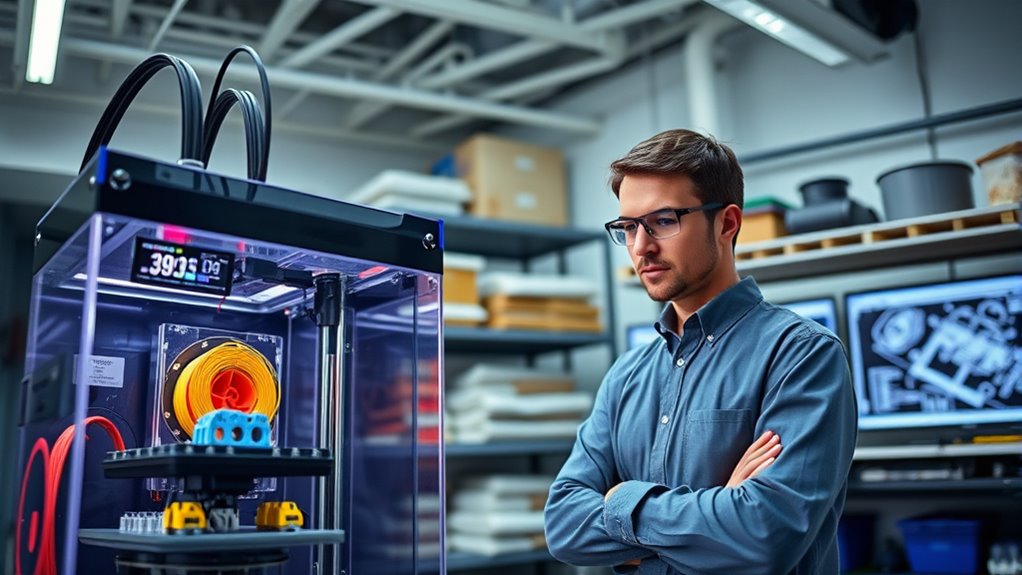Europe’s new rules for 3D printing focus on balancing repair access with protecting intellectual property rights. You’ll see requirements for clear repair clauses in contracts and support for digital rights management to safeguard designs and files. These regulations aim to make repairs easier while respecting patents and copyrights, encouraging modular, upgradable equipment, and promoting sustainable practices. To understand how these changes could impact your projects and rights, keep exploring what’s behind these new policies.
Key Takeaways
- Europe’s new rules encourage clear repair clauses and digital rights management to balance repairability with intellectual property protection.
- Regulations promote access to spare parts for 3D printing, supporting independent and third-party repair options.
- Digital files for spare parts are protected by IP laws, requiring licensing and DRM systems to prevent unauthorized sharing.
- The legislation incentivizes modular, upgradable designs to enhance machine longevity and reduce maintenance costs.
- Overall, new rules aim to foster sustainable manufacturing while safeguarding innovation and digital rights.

Have you ever wondered how repair clauses and provisions for spare parts influence the maintenance and longevity of equipment? In the domain of digital manufacturing, these elements are more vital than ever. As 3D printing becomes integral to manufacturing processes across Europe, new rules aim to balance innovation, repair rights, and intellectual property protection. When you deal with digital manufacturing, you’re working with highly sophisticated designs stored digitally, which can be easily shared or replicated. This ease of access raises questions about how repair clauses should be structured to guarantee that equipment remains functional without infringing on intellectual property rights. Under the new European regulations, manufacturers are encouraged to include clear repair clauses that specify how spare parts can be obtained and used, fostering a more sustainable approach to maintenance. These provisions enable users to fix equipment independently or through third-party services, reducing downtime and prolonging the lifespan of machinery. Additionally, the regulations support digital rights management to help protect intellectual property while promoting repairability. However, this push for easier access to spare parts and repair options also impacts intellectual property. Manufacturers often view their designs and spare parts as valuable assets, protected by patents and copyrights. The new rules aim to strike a balance: they promote repairability and sustainability without allowing unauthorized copying or distribution of protected digital files. As a user, you’ll find that repair clauses now often include limitations on how spare parts and digital files can be shared or used, guaranteeing that intellectual property rights are respected while still enabling effective repairs. This means you might need to navigate licensing agreements or digital rights management systems when sourcing spare parts or modifying equipment. Another key aspect is how these regulations influence the development of digital manufacturing technologies. With more transparent repair clauses, companies are motivated to design equipment that is easier to maintain—fostering innovation that emphasizes modularity and upgradability. This benefits you because it can translate into longer-lasting machinery, lower maintenance costs, and more control over repairs. Conversely, strict intellectual property protections ensure that companies can monetize their innovations, which fuels further investment in digital manufacturing technologies like 3D printing.
Frequently Asked Questions
How Do These Rules Affect Small 3D Printing Businesses?
These new rules mean you, as a small 3D printing business, will face stricter repair obligations and access to spare parts. You must provide spare parts for a certain period, ensuring your customers can repair products easily. This could increase your costs but also offers a chance to build trust with clients by offering better after-sales support. Staying compliant is essential to avoid penalties and maintain your reputation.
Are There Specific Penalties for Non-Compliance With New Regulations?
Yes, there are specific penalties for non-compliance with the new regulations. Penalty enforcement includes fines and sanctions, which can vary depending on the severity of the violation. You should expect compliance monitoring to be active, with authorities conducting audits and inspections regularly. If you fail to meet the rules, you risk financial penalties and potential legal actions, so it’s vital to stay updated and make certain your business adheres to all requirements.
What Are the Deadlines for Implementing These New Rules?
Imagine the clock ticking down on a busy workshop. You have until July 2024 to meet Europe’s new rules on spare part obligations and repair timelines. During this period, you must guarantee your processes align with the regulations, or risk penalties. Act now, mark your calendar, and prepare to implement these changes smoothly. Staying ahead means you’ll navigate the deadline’s storm with confidence and compliance.
How Will These Regulations Impact International Trade of 3D Printed Parts?
These regulations will reduce trade barriers by standardizing 3D printed part standards across Europe, making it easier for you to export and import. However, you’ll face increased compliance costs as you adapt to new rules, certifications, and documentation requirements. Overall, while trade becomes smoother in some areas, you’ll need to invest in ensuring your 3D printed parts meet these new standards to avoid delays or penalties.
Do These Rules Apply to All Types of 3D Printing Technologies?
Like Pandora’s box, these rules do have limits. They generally apply across various 3D printing technologies but include material restrictions and specific technology exemptions. You’ll find that certain methods, such as metal or polymer printing, might be subject to stricter rules, while others are exempt. So, while the regulations cover a broad spectrum, always check if your particular technology and materials fall under the specific exemptions or restrictions.
Conclusion
In embracing Europe’s evolving regulations, you’ll find freedom in fixing and fueling your future with flexible, fair, and forward-thinking frameworks. The repair clause and spare parts policies promote progress, practicality, and precision, pushing boundaries and breaking barriers. By balancing bold innovation with responsible regulation, you’ll gain access to opportunities, optimize ownership, and outshine obsolescence. So, seize this shift, stay steadfast, and step confidently into a sustainable, savvy, and self-sufficient 3D printing era.









